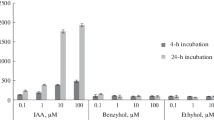Summary
The auxin-induced cell elongation and the formation of indoleacetyl-aspartic acid (IAAsp) of pea epicotyl sections and Agrostemma hypocotyl sections are inhibited by heavy water. The formation of IAAsp requires a specific enzyme. The lack of IAAsp in D2O-treated plant tissues may be due to an influence of D2O on the induction or on the synthesis of that enzyme. Treatment of plant sections with synthetic IAAsp has no effect on the growth of the sections in D2O. Indole-3-acetic acid (IAA) increases the incorporation of 32P-orthophosphate into ribosomal and soluble RNA of pea epicotyl sections in H2O but not in D2O. The synthesis of ribosomal RNA is decreased by heavy water.
The effects of IAA and D2O on the soluble proteins of pea sections have been studied by PAA-gel electrophoresis. D2O does not change the pattern of protein bands in comparison with the H2O-control, but prevents the probably IAA-induced alteration of the Rf-value of one protein band on the pherogram. It is assumed that the inhibition of auxin-induced reactions in the D2O-medium is due to the stabilizing effect of heavy water on allosteric proteins. The results of this work support the hypothesis that IAA acts as allosteric effector.
Similar content being viewed by others
Literatur
Andreae, W. A., and N. E. Good: The formation of indoleacetylaspartic acid in pea seedlings. Plant Physiol. 30, 380–382 (1955).
Cherry, J. H., and K. J. Lessman: Comparison of nucleic acids in maize shoots and pea epicotyls. Amer. J. Bot. 54, 181–188 (1967).
Cline, A. L., and R. M. Bock: Translational control of gene expression. Cold Spr. Harb. Symp. quant. Biol. 31, 321–333 (1966).
Dahlhelm, H.: Der Einfluß von D2O auf die Atmung und die Bildung von Indolylacetylasparaginsäure bei IES-behandelten Pflanzengeweben. studia biophysica 4, 145–154 (1967).
—, u. G. Hübner: D2O als Inhibitor der auxin-induzierten RNS-Synthese. Naturwissenschaften 56, 89 (1969).
Galonska, H., u. G. Hübner: Über den Ablauf von Wuchsstofftests in schwerem Wasser. Flora (Jena) 154, 388–392 (1963).
Hamilton, T. H.: Control by estrogen of genetic transcription and translation. Science 161, 649–661 (1968).
Henderson, T. R., J. M. Dacus, H. L. Crespi, and J. J. Katz: Deuterium isotope effects on β-galactosidase formation by Escherichia coli. Arch. Biochem. 120, 316–321 (1967).
—, and R. F. Henderson: Deuterium isotope effects on genetic control mechanisms. studia biophysica 4, 109–124 (1967).
Jacob, F., and J. Monod: Genetic regulatory mechanisms in the synthesis of proteins. J. molec. Biol. 3, 318–356 (1961).
Key, J. L.: Effect of purine and pyrimidine analogues on growth and RNA metabolism in soybean hypokotyl — the selective action of 5-Fluorouracil. Plant Physiol. 41, 1257–1264 (1966).
Kirby, K. S.: A new method for the isolation of ribonucleic acids from mammalian tissues. Biochem. J. 64, 405–408 (1956).
Mandell, J. D., and A. D. Hershey: A fractionating column for analysis of nucleic acids. Analyt. Biochem. 1, 66–77 (1960).
Noodén, L. D., and K. V. Thimann: Inhibition of protein synthesis and of auxininduced growth by chloramphenicol. Plant Physiol. 40, 193–201 (1965).
Ornstein, L., and B. J. Davis: Disc electrophoresis. Dist. Products Ind., Eastman Kodak Co. (1962).
Ralph, R. K., and A. R. Bellamy: Isolation and purification of undegraded ribonucleic acids. Biochim. biophys. Acta (Amst.) 87, 9–16 (1964).
Ruess, M.: Diplomarbeit, Halle/S. (1966).
Steward, F. C., R. F. Lyndon, and J. T. Barber: Acrylamide gel electrophoresis of soluble plant proteins: a study on pea seedlings in relation to development. Amer. J. Bot. 52, 155–164 (1965).
Südi, J.: Increases in the capacity of pea tissue to form acyl-aspartic acids specifically induced by auxins. New Phytologist 65, 9–21 (1966).
Tata, J. R.: The formation and distribution of ribosomes during hormone-induced growth and development. The second colworth medal lecture. Biochem. J. 104, 1–16 (1967).
Wieland, Th., u. G. Hörlein: Synthese einiger β-Indolacetylaminosäuren und-peptide. Justus Liebigs Ann. Chem. 591, 192–199 (1955).
Author information
Authors and Affiliations
Rights and permissions
About this article
Cite this article
Dahlhelm, H. Untersuchungen zum Wirkungsmechanismus von Indolyl-3-Essigsäure mit Hilfe von schwerem Wasser. Planta 86, 224–234 (1969). https://doi.org/10.1007/BF00386455
Received:
Issue Date:
DOI: https://doi.org/10.1007/BF00386455




